The Taiwanese Romanization System (Taiwanese Romanization: Tâi-uân Lô-má-jī Phing-im Hong-àn, Chinese: 臺灣閩南語羅馬字拼音方案; pinyin: Táiwān Mǐnnányǔ Luómǎzì Pīnyīn Fāng'àn; Pe̍h-ōe-jī: Tâi-ôan Lô-má-jī Pheng-im Hong-àn; often referred to as Tâi-lô) is a transcription system for Taiwanese Hokkien. It is derived from Pe̍h-ōe-jī and since 2006 has been one of the officially promoted phonetic notation system by Taiwan's Ministry of Education. It is nearly identical to Taiwanese Language Phonetic Alphabet (TLPA) Romanization for Hakka apart from using ts tsh j instead of c ch j for the fricatives /ts tsʰ dz/.
1. Alphabet
Taiwanese Romanization System uses 16 basic Latin letters (A, B, E, G, H, I, J, K, L, M, N, O, P, S, T, U), 7 digraphs (Kh, Ng, nn, Oo, Ph, Th, Ts) and a trigraph (Tsh). In addition, it uses 6 diacritics to represent tones.
| Capital letter |
A |
B |
E |
G |
H |
I |
J |
K |
Kh |
L |
M |
N |
Ng |
|
O |
Oo |
P |
Ph |
S |
T |
Th |
Ts |
Tsh |
U |
| Lower case |
a |
b |
e |
g |
h |
i |
j |
k |
kh |
l |
m |
n |
ng |
nn |
o |
oo |
p |
ph |
s |
t |
th |
ts |
tsh |
u |

- "nn" is only used after a vowel to express nasalization, so it has no capital letter.
- Palatalization occurs when "J, S, Ts, Tsh" followed by "i", so "Ji, Si, Tsi, Tshi" sometimes governed as trigraphs and tetragraphs.
- Of the 10 unused basic Latin letters, "R" is sometimes used to express dialectal vowels, while the others (C, D, F, Q, V, W, X, Y, Z) are only used in loanwords.
2. Values
2.1. Consonants
Initials
| |
Bilabial |
Alveolar |
Alveolo-palatal |
Velar |
Glottal |
| Voiceless |
Voiced |
Voiceless |
Voiced |
Voiceless |
Voiced |
Voiceless |
Voiced |
Voiceless |
| Nasal |
|
m [m]
ㄇ 毛(moo) |
|
n [n]
ㄋ 耐(nāi) |
|
|
|
ng [ŋ]
ㄫ 雅(ngá) |
|
| Plosive |
Unaspirated |
p [p]
ㄅ 邊(pian) |
b [b]
ㆠ 文(bûn) |
t [t]
ㄉ 地(tē) |
|
|
|
k [k]
ㄍ 求(kiû) |
g [g]
ㆣ 語(gí) |
|
| Aspirated |
ph [pʰ]
ㄆ 波(pho) |
|
th [tʰ]
ㄊ 他(thann) |
|
|
|
kh [kʰ]
ㄎ 去(khì) |
|
|
| Affricate |
Unaspirated |
|
|
ts [ts]
ㄗ 曾(tsan) |
j [dz]
ㆡ 熱(jua̍h) |
tsi [tɕ]
ㄐ 尖(tsiam) |
ji [dʑ]
ㆢ 入(ji̍p) |
|
|
|
| Aspirated |
|
|
tsh [tsʰ]
ㄘ 出(tshut) |
|
tshi [tɕʰ]
ㄑ 手(tshiú) |
|
|
|
|
| Fricative |
|
|
s [s]
ㄙ 衫(sann) |
|
si [ɕ]
ㄒ 寫(siá) |
|
|
|
h [h]
ㄏ 喜(hí) |
| Lateral |
|
|
|
l [l]
ㄌ 柳(liú) |
|
|
|
|
|
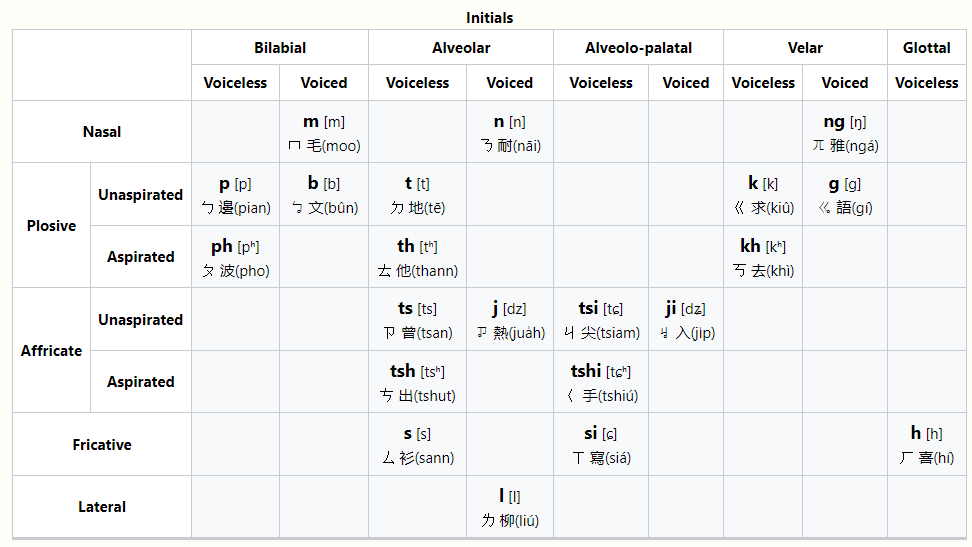
Finals
| |
Bilabial |
Alveolar |
Velar |
Glottal |
| Nasal consonant |
-m [m]
ㆬ |
-n [n]
ㄣ |
-ng [ŋ]
ㆭ |
|
| Stop consonant |
-p [p̚]
ㆴ |
-t [t̚]
ㆵ |
-k [k̚]
ㆶ |
-h [ʔ]
ㆷ |
|
Syllabic consonant
| |
Bilabial |
Velar |
| Nasal |
m [m̩]
ㆬ 姆(ḿ) |
ng [ŋ̍]
ㆭ 酸(sng) |
|
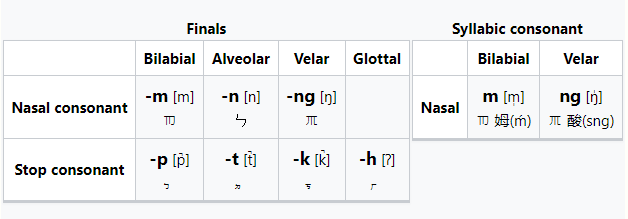
2.2. Vowels & Rhymes
Simple & Nasal
| |
Front |
Central |
Back |
| Simple |
Nasal |
Simple |
Simple |
Nasal |
| Close |
i [i]
ㄧ 衣(i) |
inn [ĩ]
ㆪ 圓(înn) |
|
u [u]
ㄨ 污(u) |
unn [ũ]
ㆫ 張(tiunn) |
| Mid |
e [e]
ㆤ 禮(lé) |
enn [ẽ]
ㆥ 生(senn) |
o[ə]
ㄜ 高(ko) |
oo [ɔ]
ㆦ 烏(oo) |
onn [ɔ̃]
ㆧ 翁(onn) |
| Open |
a [a]
ㄚ 查(tsa) |
ann [ã]
ㆩ 衫(sann) |
|
|
|
|
Dialect
| Tâi-lô |
IPA |
Bopomofo |
| ir |
[ɨ] |
ㆨ |
| er |
[ə] |
ㄜ |
| ee |
[ɛ] |
ㄝ |
| ere |
[əe] |
ㄜㆤ[1] |
|
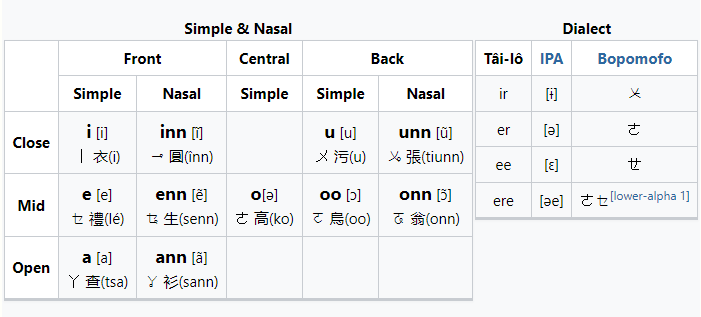
- o pronounced [ə] ㄜ in general dialect in Kaohsiung and Tainan, [o] ㄛ in Taipei.
- -nn forms the nasal vowels
- There is also syllabic m and ng.
| Vowel(s) |
Open syllabus |
Nasal |
Plosive |
| [m] |
[n] |
[ŋ] |
[p̚] |
[t̚] |
[k̚] |
[ʔ] |
| [a] |
a |
ann |
am |
an |
ang |
ap |
at |
ak |
ah |
annh |
| [ai] |
ai |
ainn |
|
|
|
|
|
|
aih |
ainnh |
| [au] |
au |
|
|
|
|
|
|
|
auh |
|
| [e] |
e |
enn |
|
|
|
|
|
|
eh |
ennh |
| [i] |
i |
inn |
im |
in |
ing |
ip |
it |
ik |
ih |
innh |
| [ia] |
ia |
iann |
iam |
ian |
iang |
iap |
iat |
iak |
iah |
iannh |
| [iau] |
iau |
iaunn |
|
|
|
|
|
|
iauh |
|
| [iə] |
io |
|
|
|
|
|
|
|
ioh |
|
| [iɔ] |
|
|
|
|
iong |
|
|
iok |
|
|
| [iu] |
iu |
iunn |
|
|
|
|
|
|
iuh |
iunnh |
|
| Vowel(s) |
Open syllabus |
Nasal |
Plosive |
| [m] |
[n] |
[ŋ] |
[p̚] |
[t̚] |
[k̚] |
[ʔ] |
| [ə] |
o |
|
|
|
|
|
|
|
oh |
|
| [ɔ] |
oo |
onn |
om |
|
ong |
op |
|
ok |
ooh |
onnh |
| [u] |
u |
|
|
un |
|
|
ut |
|
uh |
|
| [ua] |
ua |
uann |
|
uan |
|
|
uat |
|
uah |
|
| [uai] |
uai |
uainn |
|
|
|
|
|
|
|
|
| [ue] |
ue |
|
|
|
|
|
|
|
ueh |
|
| [ui] |
ui |
|
|
|
|
|
|
|
|
|
| [m̩] |
m |
- |
mh |
| [ŋ̍] |
ng |
- |
ngh |
|
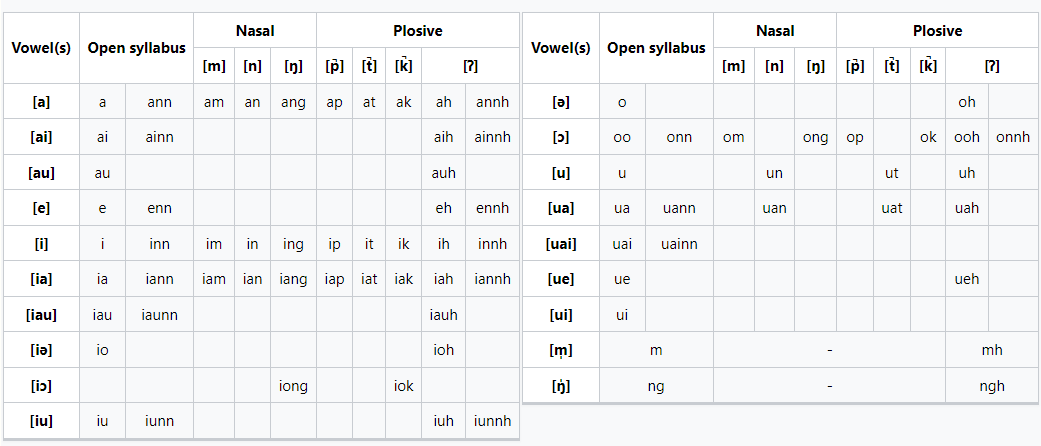
- ing pronounced [ɪəŋ], ik pronounced [ɪək̚].
2.3. Tones
| Tone No. |
1 |
2 |
3 |
4 |
5 |
7 |
8 |
| Name |
陰平 |
上聲 |
陰去 |
陰入 |
陽平 |
陽去 |
陽入 |
| im-pîng |
siōng-siann |
im-khì |
im-ji̍p |
iông-pîng |
iông-khì |
iông-ji̍p |
| Symbol |
None |
Acute |
Grave |
None (-p, -t, -k, -h) |
Circumflex |
macron |
Vertical line above (-p, -t, -k, -h) |
| |
´ |
` |
|
ˆ |
ˉ |
̍ |
| Pitch |
˥˥ |
˥˩ |
˧˩ |
˧ʔ |
˨˦ |
˧˧ |
˥ʔ |
| 55 |
51 |
31 |
3ʔ |
24 |
33 |
5ʔ |
| Example |
tong (東) |
tóng (黨) |
tòng (棟) |
tok (督) |
tông (同) |
tōng (洞) |
to̍k (毒) |
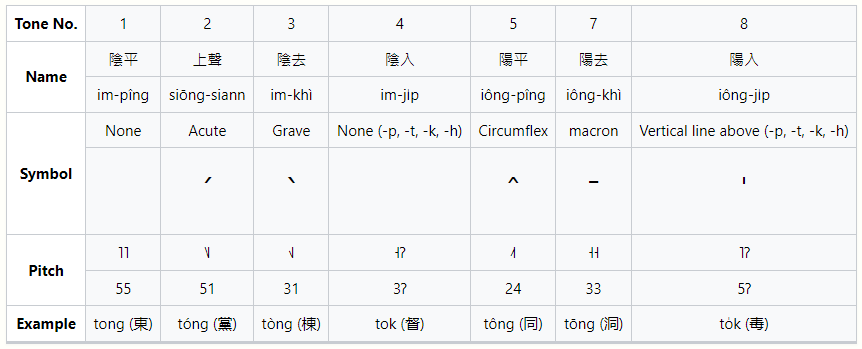
A hyphen links elements of a compound word. A double hyphen indicates that the following syllable has a neutral tone and therefore that the preceding syllable does not undergo tone sandhi.
| Licit syllables[2] |
| |
Ø |
b |
g |
h |
j |
k |
kh |
l |
m |
n |
ng |
p |
ph |
s |
t |
th |
ts |
tsh |
|
| a |
a |
ba |
ga |
ha |
|
ka |
kha |
la |
ma |
na |
nga |
pa |
pha |
sa |
ta |
tha |
tsa |
tsha |
a |
| ah |
ah |
bah |
|
hah |
|
kah |
khah |
lah |
|
nah |
|
pah |
phah |
sah |
tah |
thah |
tsah |
tshah |
ah |
| ai |
ai |
bai |
gai |
hai |
|
kai |
khai |
lai |
mai |
nai |
ngai |
pai |
phai |
sai |
tai |
thai |
tsai |
tshai |
ai |
| ainn |
ainn |
|
|
hainn |
|
kainn |
khainn |
|
|
|
|
|
phainn |
|
tainn |
|
tsainn |
|
ainn |
| ak |
ak |
bak |
gak |
hak |
|
kak |
khak |
lak |
|
|
|
pak |
phak |
sak |
tak |
thak |
tsak |
tshak |
ak |
| am |
am |
|
gam |
ham |
|
kam |
kham |
lam |
|
|
|
|
|
sam |
tam |
tham |
tsam |
tsham |
am |
| an |
an |
ban |
gan |
han |
|
kan |
khan |
lan |
|
|
|
pan |
phan |
san |
tan |
than |
tsan |
tshan |
an |
| ang |
ang |
bang |
gang |
hang |
|
kang |
khang |
lang |
|
|
|
pang |
phang |
sang |
tang |
thang |
tsang |
tshang |
ang |
| ann |
ann |
|
|
hann |
|
kann |
khann |
|
|
|
|
|
phann |
sann |
tann |
thann |
tsann |
tshann |
ann |
| annh |
|
|
|
hannh |
|
|
|
|
|
|
|
|
|
sannh |
|
|
|
|
annh |
| ap |
ap |
|
|
hap |
|
kap |
khap |
lap |
|
|
|
|
|
sap |
tap |
thap |
tsap |
tshap |
ap |
| at |
at |
bat |
|
hat |
|
kat |
khat |
lat |
|
|
|
pat |
|
sat |
tat |
that |
tsat |
tshat |
at |
| au |
au |
bau |
gau |
hau |
|
kau |
khau |
lau |
mau |
nau |
ngau |
pau |
phau |
sau |
tau |
thau |
tsau |
tshau |
au |
| auh |
|
|
|
|
|
kauh |
|
lauh |
mauh |
nauh |
|
|
phauh |
|
tauh |
|
|
tshauh |
auh |
| e |
e |
be |
ge |
he |
|
ke |
khe |
le |
me |
ne |
nge |
pe |
phe |
se |
te |
the |
tse |
tshe |
e |
| eh |
eh |
beh |
|
heh |
|
keh |
kheh |
leh |
meh |
neh |
ngeh |
peh |
|
seh |
teh |
theh |
tseh |
tsheh |
eh |
| enn |
enn |
|
|
henn |
|
kenn |
khenn |
|
|
|
|
penn |
phenn |
senn |
tenn |
thenn |
tsenn |
tshenn |
enn |
| ennh |
|
|
|
hennh |
|
|
khennh |
|
|
|
|
|
|
|
|
|
|
|
ennh |
| i |
i |
bi |
gi |
hi |
ji |
ki |
khi |
li |
mi |
ni |
|
pi |
phi |
si |
ti |
thi |
tsi |
tshi |
i |
| ia |
ia |
|
gia |
hia |
jia |
kia |
khia |
|
mia |
nia |
ngia |
|
|
sia |
tia |
|
tsia |
tshia |
ia |
| iah |
iah |
|
giah |
hiah |
|
kiah |
khiah |
liah |
|
|
|
piah |
phiah |
siah |
tiah |
thiah |
tsiah |
tshiah |
iah |
| iak |
|
|
|
|
|
|
khiak |
|
|
|
|
piak |
phiak |
siak |
tiak |
|
|
tshiak |
iak |
| iam |
iam |
|
giam |
hiam |
jiam |
kiam |
khiam |
liam |
|
|
|
|
|
siam |
tiam |
thiam |
tsiam |
tshiam |
iam |
| ian |
ian |
bian |
gian |
hian |
jian |
kian |
khian |
lian |
|
|
|
pian |
phian |
sian |
tian |
thian |
tsian |
tshian |
ian |
| iang |
iang |
|
giang |
hiang |
jiang |
|
khiang |
liang |
|
|
|
piang |
phiang |
siang |
|
|
tsiang |
tshiang |
iang |
| iann |
iann |
|
|
hiann |
|
kiann |
|
|
|
|
|
piann |
|
siann |
tiann |
thiann |
tsiann |
tshiann |
iann |
| iannh |
|
|
|
hiannh |
|
|
|
|
|
|
|
|
|
|
|
|
|
|
iannh |
| iap |
iap |
|
giap |
hiap |
jiap |
kiap |
khiap |
liap |
|
|
|
|
|
siap |
tiap |
thiap |
tsiap |
tshiap |
iap |
| iat |
iat |
biat |
giat |
hiat |
jiat |
kiat |
khiat |
liat |
|
|
|
piat |
phiat |
siat |
tiat |
thiat |
tsiat |
tshiat |
iat |
| iau |
iau |
biau |
giau |
hiau |
jiau |
kiau |
khiau |
liau |
miau |
niau |
ngiau |
piau |
phiau |
siau |
tiau |
thiau |
tsiau |
tshiau |
iau |
| iauh |
|
|
|
hiauh |
|
|
khiauh |
|
|
|
ngiauh |
|
|
|
|
|
|
|
iauh |
| iaunn |
iaunn |
|
|
|
|
|
|
|
|
|
|
|
|
|
|
|
|
|
iaunn |
| ih |
|
bih |
|
|
|
|
khih |
|
mih |
nih |
|
pih |
phih |
sih |
tih |
thih |
tsih |
tshih |
ih |
| ik |
ik |
bik |
gik |
hik |
|
kik |
|
lik |
|
|
|
pik |
phik |
sik |
tik |
thik |
tsik |
tshik |
ik |
| im |
im |
|
gim |
him |
jim |
kim |
khim |
lim |
|
|
|
|
|
sim |
tim |
thim |
tsim |
tshim |
im |
| in |
in |
bin |
gin |
hin |
jin |
kin |
khin |
lin |
|
|
|
pin |
phin |
sin |
tin |
thin |
tsin |
tshin |
in |
| ing |
ing |
|
ging |
hing |
|
king |
khing |
ling |
|
|
|
ping |
phing |
sing |
ting |
thing |
tsing |
tshing |
ing |
| inn |
inn |
|
|
hinn |
|
kinn |
khinn |
|
|
|
|
|
|
sinn |
tinn |
thinn |
tsinn |
tshinn |
inn |
| io |
io |
bio |
gio |
hio |
jio |
kio |
khio |
lio |
|
|
|
pio |
phio |
sio |
tio |
thio |
tsio |
tshio |
io |
| ioh |
ioh |
|
gioh |
hioh |
|
kioh |
khioh |
lioh |
|
|
|
|
|
sioh |
tioh |
|
tsioh |
tshioh |
ioh |
| iok |
iok |
|
giok |
hiok |
jiok |
kiok |
khiok |
liok |
|
|
|
|
|
siok |
tiok |
thiok |
tsiok |
tshiok |
iok |
| iong |
iong |
|
giong |
hiong |
jiong |
kiong |
khiong |
liong |
|
|
|
|
|
siong |
tiong |
thiong |
tsiong |
tshiong |
iong |
| ip |
ip |
|
|
hip |
jip |
kip |
khip |
lip |
|
|
|
|
|
sip |
|
|
tsip |
tship |
ip |
| it |
it |
bit |
|
hit |
jit |
kit |
khit |
|
|
|
|
pit |
phit |
sit |
tit |
|
tsit |
tshit |
it |
| iu |
iu |
biu |
giu |
hiu |
jiu |
kiu |
khiu |
liu |
|
niu |
|
piu |
|
siu |
tiu |
thiu |
tsiu |
tshiu |
iu |
| iunn |
iunn |
|
|
hiunn |
|
kiunn |
khiunn |
|
|
|
|
|
|
siunn |
tiunn |
|
tsiunn |
tshiunn |
iunn |
| iunnh |
iunnh |
|
|
hiunnh |
|
|
|
|
|
|
|
|
|
|
|
|
|
|
iunnh |
| m |
m |
|
|
hm |
|
|
|
|
|
|
|
|
|
|
|
|
|
|
m |
| mh |
|
|
|
hmh |
|
|
|
|
|
|
|
|
|
|
|
|
|
|
mh |
| ng |
ng |
|
|
hng |
|
kng |
khng |
|
mng |
nng |
|
png |
|
sng |
tng |
thng |
tsng |
tshng |
ng |
| ngh |
|
|
|
hngh |
|
|
|
|
|
|
|
|
phngh |
sngh |
|
|
|
tshngh |
ngh |
| o |
o |
bo |
go |
ho |
|
ko |
kho |
lo |
|
|
|
po |
pho |
so |
to |
tho |
tso |
tsho |
o |
| oh |
oh |
|
|
hoh |
|
koh |
|
loh |
|
|
|
poh |
phoh |
soh |
toh |
thoh |
tsoh |
tshoh |
oh |
| ok |
ok |
bok |
gok |
hok |
|
kok |
khok |
lok |
|
|
|
pok |
phok |
sok |
tok |
thok |
tsok |
tshok |
ok |
| om |
om |
|
|
|
|
|
|
|
|
|
|
|
|
som |
tom |
|
|
|
om |
| ong |
ong |
bong |
gong |
hong |
|
kong |
khong |
long |
|
|
|
pong |
phong |
song |
tong |
thong |
tsong |
tshong |
ong |
| onn |
onn |
|
|
honn |
|
konn |
|
|
|
|
|
|
|
|
|
|
|
|
onn |
| onnh |
onnh |
|
|
honnh |
|
|
|
|
|
|
|
|
|
|
|
|
|
|
onnh |
| oo |
oo |
boo |
goo |
hoo |
|
koo |
khoo |
loo |
moo |
noo |
ngoo |
poo |
phoo |
soo |
too |
thoo |
tsoo |
tshoo |
oo |
| ooh |
|
|
|
|
|
|
|
|
mooh |
|
|
|
|
|
|
|
|
|
ooh |
| u |
u |
bu |
gu |
hu |
ju |
ku |
khu |
lu |
|
|
|
pu |
phu |
su |
tu |
thu |
tsu |
tshu |
u |
| ua |
ua |
bua |
gua |
hua |
|
kua |
khua |
lua |
mua |
nua |
|
pua |
phua |
sua |
tua |
thua |
tsua |
tshua |
ua |
| uah |
uah |
buah |
|
huah |
juah |
kuah |
khuah |
luah |
|
|
|
puah |
phuah |
suah |
|
thuah |
tsuah |
tshuah |
uah |
| uai |
uai |
|
|
huai |
|
kuai |
khuai |
|
|
|
|
|
|
suai |
|
|
|
|
uai |
| uainn |
uainn |
|
|
huainn |
|
kuainn |
|
|
|
|
|
|
|
suainn |
|
|
tsuainn |
|
uainn |
| uan |
uan |
buan |
guan |
huan |
|
kuan |
khuan |
luan |
|
|
|
puan |
phuan |
suan |
tuan |
thuan |
tsuan |
tshuan |
uan |
| uang |
uang |
|
|
|
|
|
|
|
|
|
|
|
|
|
|
|
|
tshuang |
uang |
| uann |
uann |
|
|
huann |
|
kuann |
khuann |
|
|
|
|
puann |
phuann |
suann |
tuann |
thuann |
|
tshuann |
uann |
| uat |
uat |
buat |
guat |
huat |
|
kuat |
khuat |
luat |
|
|
|
puat |
phuat |
suat |
tuat |
thuat |
tsuat |
|
uat |
| ue |
ue |
bue |
gue |
hue |
jue |
kue |
khue |
lue |
|
|
|
pue |
phue |
sue |
tue |
|
tsue |
tshue |
ue |
| ueh |
ueh |
bueh |
gueh |
hueh |
|
kueh |
khueh |
|
|
|
|
pueh |
phueh |
sueh |
|
|
|
|
ueh |
| uh |
uh |
|
|
|
|
|
khuh |
|
|
|
|
puh |
phuh |
|
tuh |
thuh |
tsuh |
tshuh |
uh |
| ui |
ui |
bui |
gui |
hui |
|
kui |
khui |
lui |
mui |
|
|
pui |
phui |
sui |
tui |
thui |
tsui |
tshui |
ui |
| un |
un |
bun |
gun |
hun |
jun |
kun |
khun |
lun |
|
|
|
pun |
phun |
sun |
tun |
thun |
tsun |
tshun |
un |
| ut |
ut |
but |
|
hut |
|
kut |
khut |
lut |
|
|
|
put |
phut |
sut |
tut |
thut |
tsut |
tshut |
ut |
| |
Ø |
b |
g |
h |
j |
k |
kh |
l |
m |
n |
ng |
p |
ph |
s |
t |
th |
ts |
tsh |
|
|






